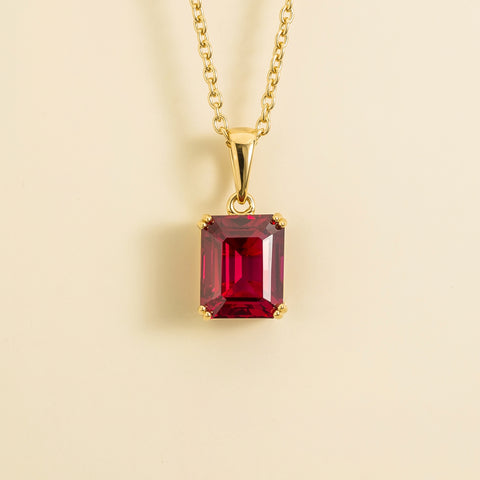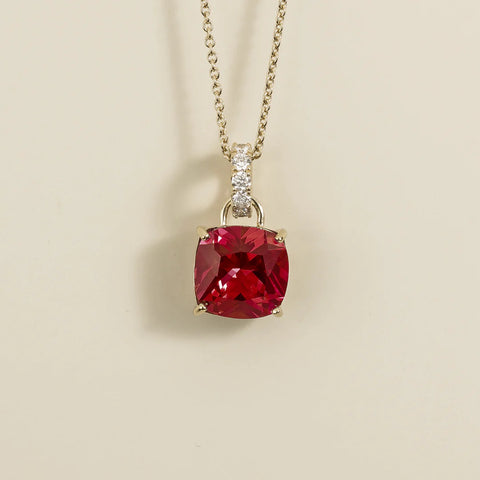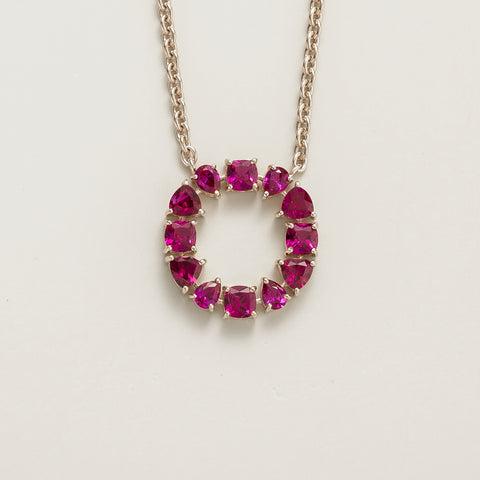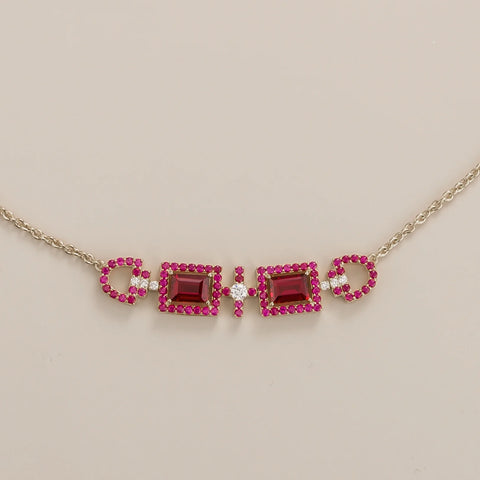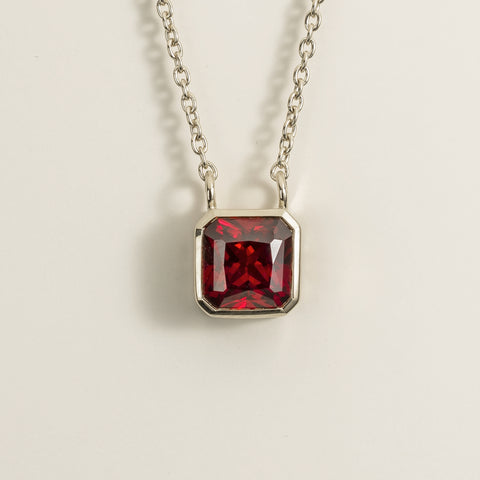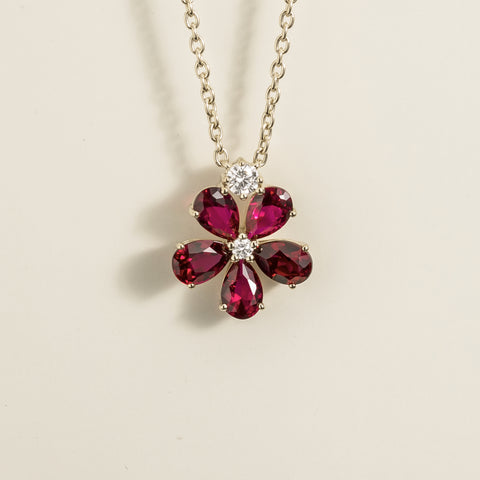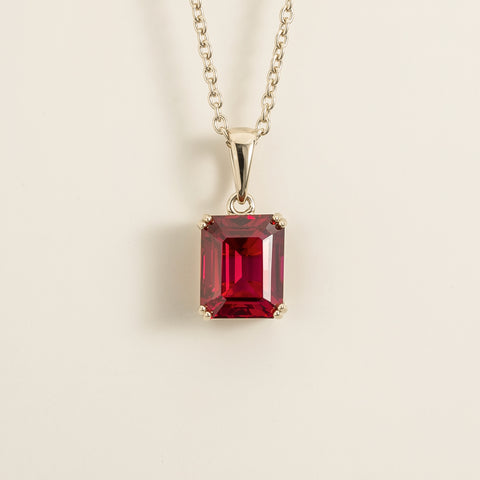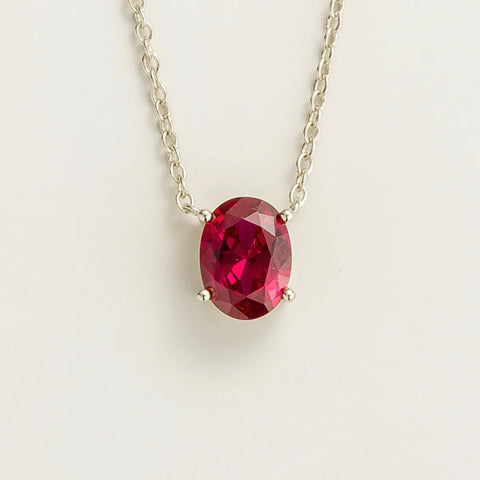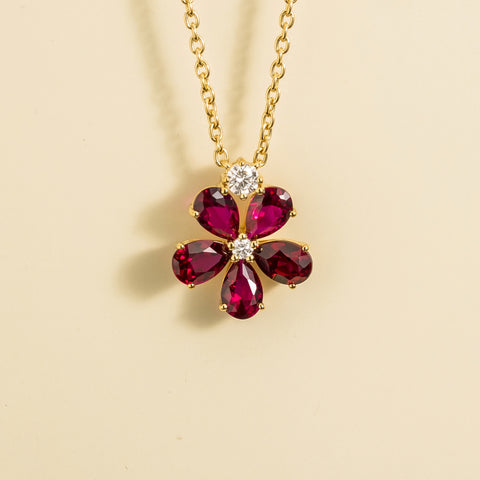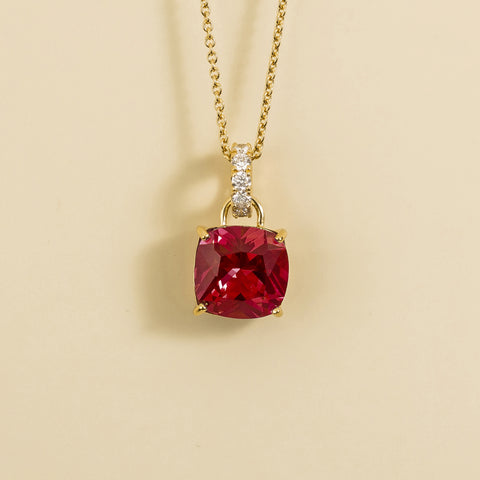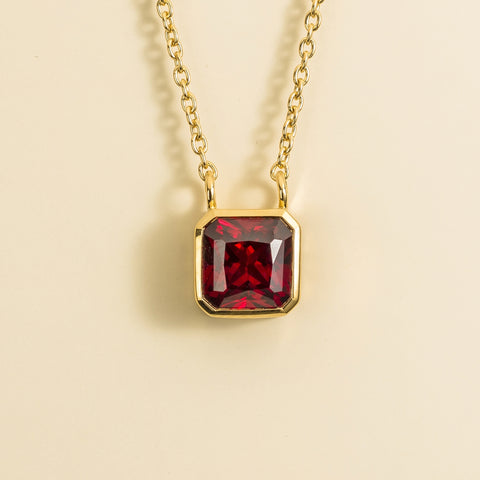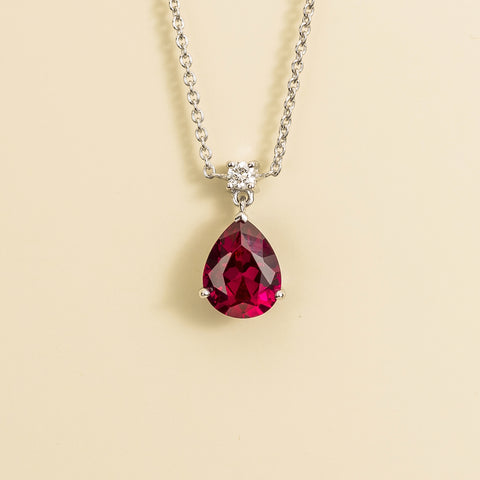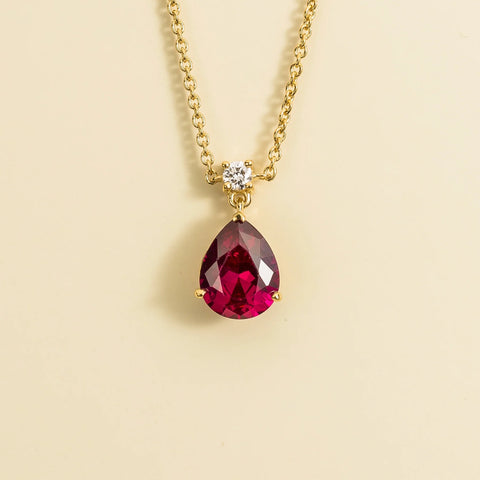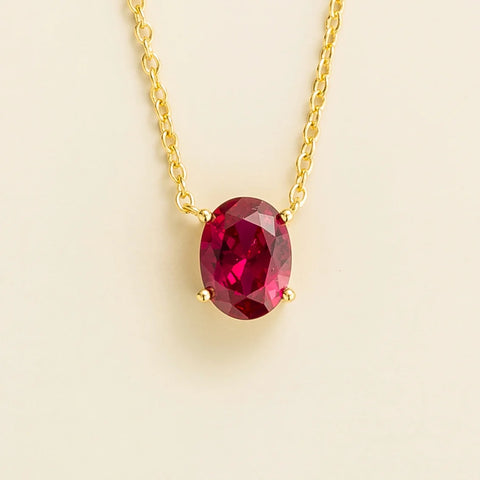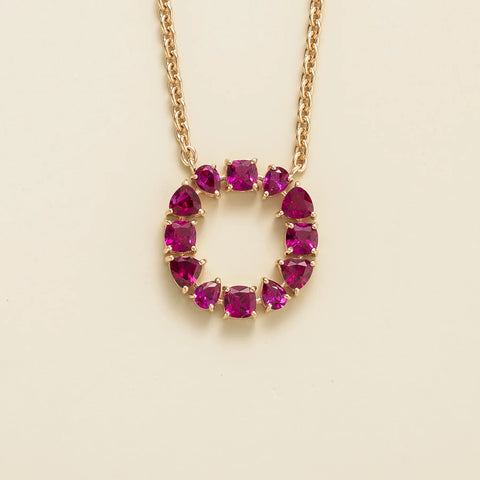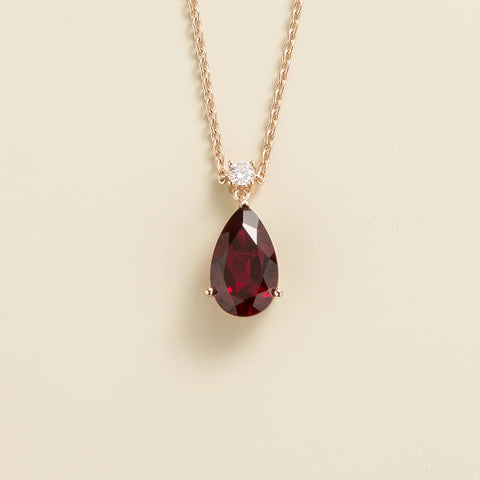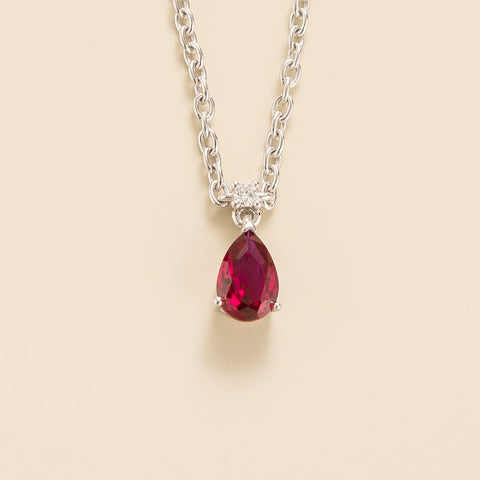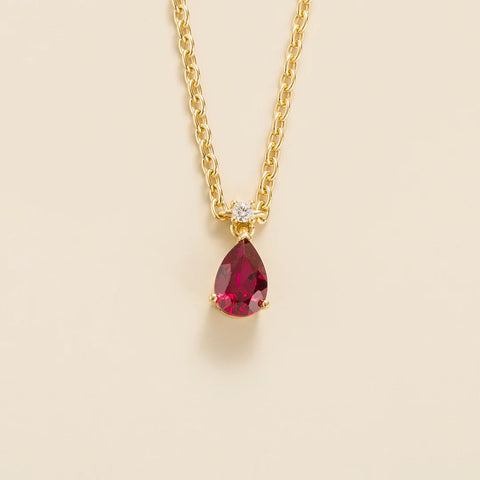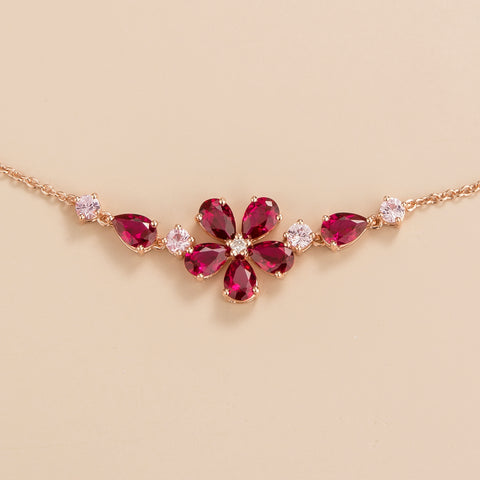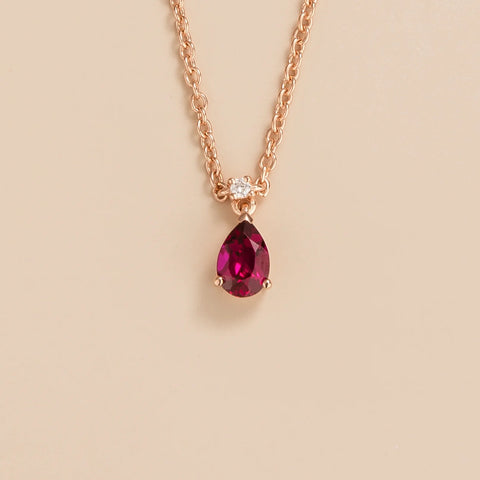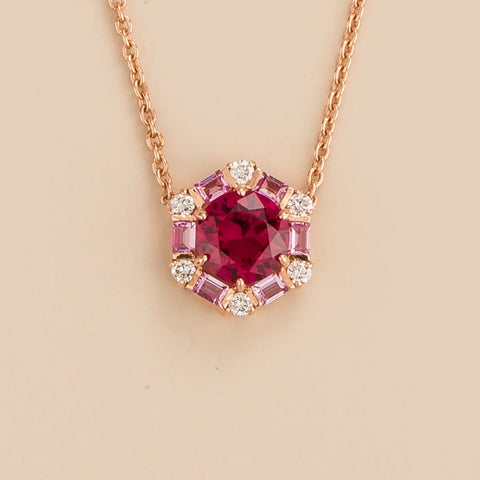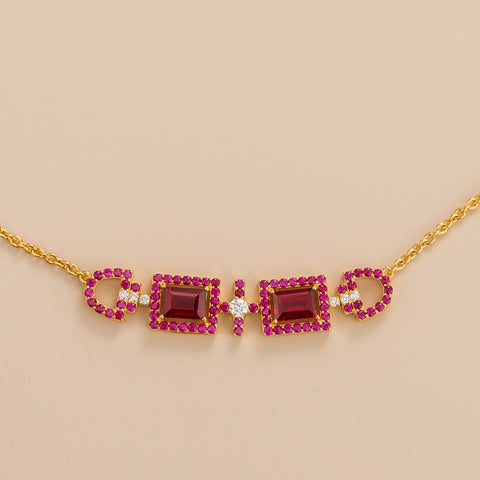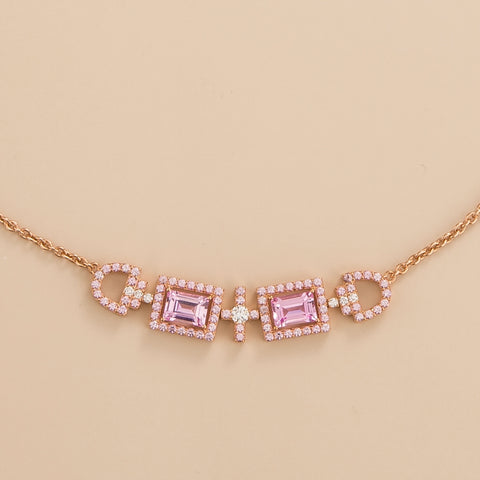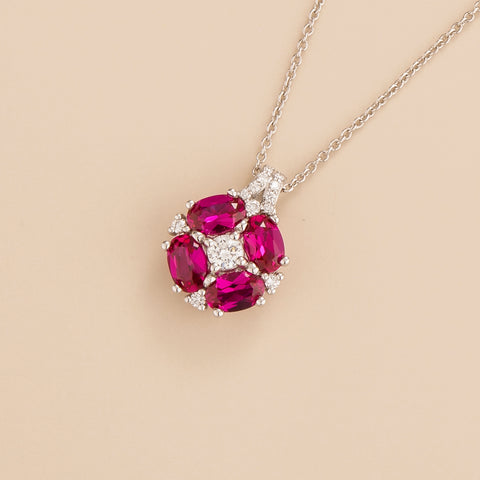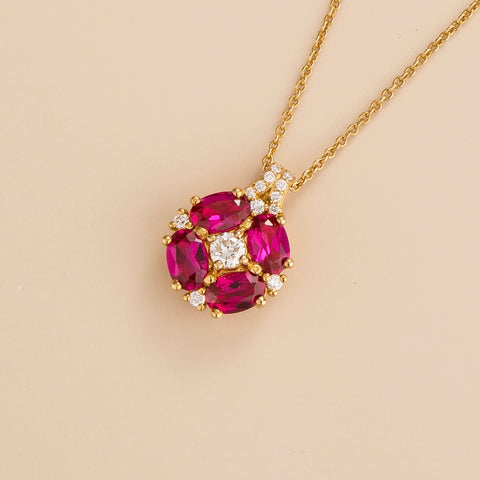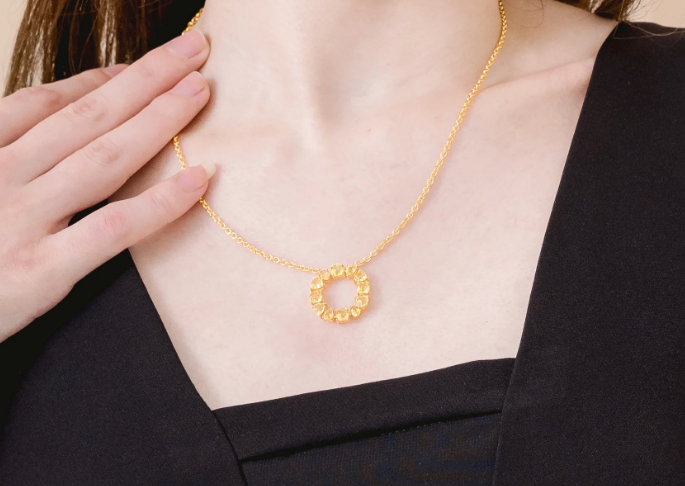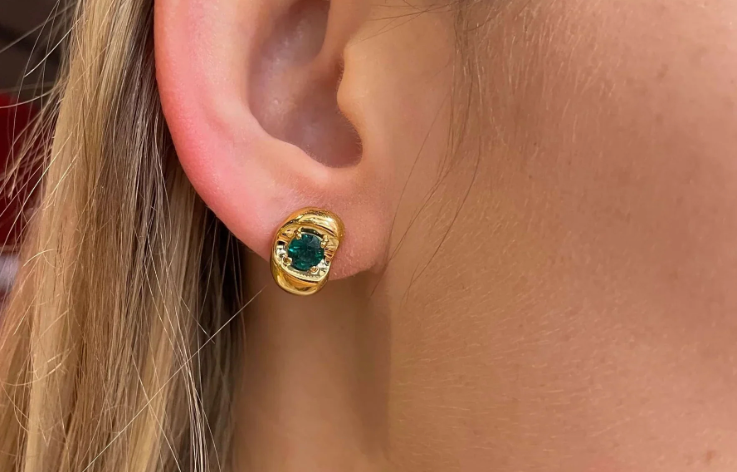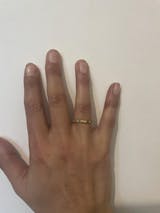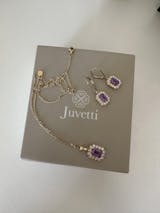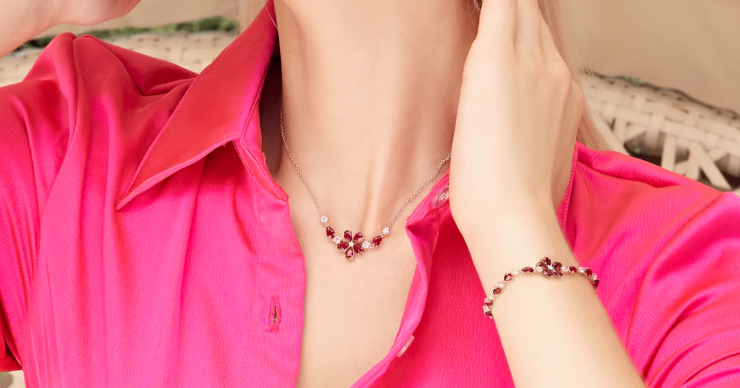
From Royalty to Runways: The Rich History of Ruby Necklaces
Table of Content: Inside this Article
...At Juvetti, we have a deep appreciation for the rich history and cultural significance of ruby necklaces.
As bespoke jewellers, we understand the importance of crafting pieces that not only showcase the inherent beauty of rubies but also pay homage to the centuries of artisanship and tradition that have shaped the way we perceive and value these precious gemstones.
In this article, we invite you to embark on a captivating journey through the epochs of history, exploring the fascinating evolution of ruby necklaces from ancient times to the present day.
We will dive deep into the earliest known examples of ruby gemstone necklaces in ancient civilisations, uncover the mythical and spiritual meanings attached to these gemstones, and trace their path through the medieval and Renaissance eras, where they became symbols of wealth, status, and power.
As we traverse the centuries, we will encounter the opulent ruby necklaces of the Victorian era, where these pieces reached new heights of popularity and fashion.
We will also explore the bold and geometric designs of the Art Deco period, which saw ruby pendant necklaces take on a more modern and avant-garde aesthetic.
Through this journey, we will not only gain a deeper understanding of the historical and cultural significance of ruby necklaces but also appreciate the skill, craftsmanship, and creativity that have gone into their creation over the centuries.
From the ancient art of ruby bead drilling and stringing to the innovative cutting and setting techniques of the modern era, we will see how the design and manufacture of antique ruby necklaces have evolved to meet the changing tastes and demands of each era.
Ancient Ruby Necklaces
The story of ruby gemstone necklaces begins in the mists of antiquity, with the earliest known examples dating back to ancient civilisations in India and China.
These early necklaces were often simple in design, featuring rudimentary beads or rough-cut stones strung together on silk or gold threads.
Despite their primitive construction, they were highly prized for their rarity and beauty, and were often reserved for the nobility and ruling classes.
In ancient India, rubies were known as "ratnaraj" or "king of gems" and were believed to possess mystical powers and bring good fortune to those who wore them.
The ancient Sanskrit text, the "Ratnapariksha" describes the ideal ruby as "a drop of blood on a blade of grass", highlighting the deep red colour that was so highly prized.
Some interesting facts for rubies and Ancient India:
-
The ancient Sanskrit text "Ratnapariksha" (circa 5th-6th century CE) provides detailed descriptions of rubies and their properties, showcasing the advanced knowledge of gemstones in ancient India.
-
The famous Indian epic "Ramayana" (circa 5th-4th century BCE) mentions a necklace adorned with rubies and other precious gems, gifted to Sita by her father, King Janaka.
-
The ancient Indian city of Golconda (modern-day Hyderabad) was renowned for its ruby mines and was a major center of ruby trade in the ancient world.
-
The "Samudra Manthan" or "Churning of the Ocean" story in Hindu mythology mentions the emergence of a celestial ruby during the process, further emphasizing the gem's divine associations in ancient Indian culture.
Similarly, in ancient China, rubies were associated with the life force or "chi" and were believed to promote vitality, strength, and courage.
Chinese emperors and empresses often wore elaborate ruby jewellery as a symbol of their power and authority, and these pieces were frequently buried with them in their tombs to accompany them in the afterlife.
Some interesting facts for rubies and Ancient China:
-
The Chinese have been using rubies in jewellery since the North Wei Dynasty (386-534 CE), with ruby pendant necklaces being particularly popular among the nobility.
-
The ancient Chinese believed that rubies could protect the wearer from evil spirits and bring good fortune, making them highly sought-after gemstones.
-
The famous Chinese explorer Zhang Qian (circa 164-114 BCE) is credited with establishing the Silk Road trade routes, which facilitated the exchange of rubies and other precious gemstones between China and the Western world.
-
The Ming Dynasty (1368-1644 CE) saw a significant increase in the use of rubies in imperial jewellery, with many elaborate imperial ruby pieces being created for the emperors and their consorts.
-
The Chinese also developed advanced techniques for carving and engraving rubies, creating intricate designs and patterns that showcased the gem's beauty and enhanced its value.
Beyond their practical and symbolic value, ruby gemstone necklaces also featured prominently in the myths and legends of many ancient cultures.
In Greek and Roman mythology, rubies were associated with the gods and were believed to have been formed from the blood of Adonis, the lover of Aphrodite.
In Hindu mythology, rubies were said to be the tears of the god Shiva, shed in moments of intense emotion.
These ancient myths and beliefs surrounding rubies added to their allure and mystique, and helped to establish them as one of the most sought-after gemstones in the ancient world.
As trade routes expanded and new sources of rubies were discovered, the popularity of ruby jewellery spread beyond their original cultural boundaries, setting the stage for their enduring appeal in the centuries to come.
Read More: Mix and Match: Pairing Ruby Earrings with Other JewelleryMedieval Ruby Necklaces
As we move forward in time, the popularity and significance of ruby vintage necklaces continued to grow, particularly during the medieval period in Europe.
This era saw a resurgence of interest in gemstones, driven in part by the expansion of trade routes and the increasing wealth and power of the nobility.
The popularity of ruby necklaces in medieval Europe
-
Ruby antique necklaces in the Byzantine Empire, with its capital in Constantinople (modern-day Istanbul), was renowned for its wealth, luxury, and exquisite craftsmanship. Byzantine jewellers were particularly skilled in the art of goldsmithing and gem-setting, and ruby stone necklaces were among their most sought-after creations.
Byzantine ruby gemstone necklaces often featured intricate gold settings, with the rubies arranged in elaborate patterns and designs.
These pieces were worn by the imperial family and the highest echelons of society, serving as powerful symbols of wealth, status, and authority.
-
The influence of the Silk Road on ruby trade The medieval period also saw the expansion of the Silk Road, a network of trade routes that connected Europe and Asia. This facilitated the exchange of goods, ideas, and cultural influences between the two continents, and played a significant role in the spread of vintage ruby necklaces.
As rubies from the mines of Central and South Asia made their way westward along the Silk Road, they became increasingly popular among the European nobility.
The rarity and beauty of these gemstones, combined with their exotic origins, made them highly prized and sought-after.
Ruby Necklaces in Religious Texts
-
The mention of rubies in the Bible Rubies are mentioned several times in the Bible, often in the context of divine favor and spiritual significance. In the Book of Proverbs, for example, wisdom is described as being "more precious than rubies" (Proverbs 8:11), while in the Book of Job, the value of wisdom is said to surpass that of rubies (Job 28:18).
These biblical references to rubies helped to imbue the gemstone with a sense of religious and spiritual significance, making ruby pieces popular among the devout as well as the wealthy and powerful.
-
The significance of rubies in Islamic and Hindu texts In Islamic tradition, rubies are associated with the sun and are believed to bring good fortune, protection, and spiritual enlightenment to those who wear them. The famous Persian poet Rumi even wrote of rubies as being "the light of God".
Similarly, in Hindu texts, rubies are often linked to the god Surya, the personification of the sun.
They are also associated with the goddess Lakshmi, who is said to bestow wealth, prosperity, and good fortune upon her devotees.
These religious and spiritual associations helped to elevate the status of ruby jewellery during the medieval period, making them not only symbols of wealth and power but also objects of devotion and spiritual significance.
Renaissance Ruby Necklaces
As we step into the Renaissance era, we see a renewed interest in classical art, culture, and philosophy, which had a profound impact on the design and craftsmanship of ruby jewellery necklaces.
This period, spanning from the 14th to the 17th century, was marked by a resurgence of creativity, innovation, and artistic expression, which is beautifully reflected in the antique necklaces of the time.
The resurgence of ruby necklaces during the Renaissance
-
Ruby neck pieces in the Italian Renaissance courts. The Italian Renaissance courts were renowned for their patronage of the arts, and jewellery was no exception. The wealthy and powerful families of Italy, such as the Medici and the Borgia, commissioned exquisite ruby pendant necklaces as symbols of their prestige and influence.
These necklaces often featured intricate gold settings, with rubies arranged in delicate patterns and adorned with other precious gemstones such as pearls and diamonds.
The designs were influenced by classical motifs and themes, such as mythological creatures, floral patterns, and architectural elements.
-
The symbolism of rubies in Renaissance art and literature During the Renaissance. Rubies were often associated with concepts such as love, passion, and nobility. In art and literature, they were used to symbolize the intensity of emotion, the power of the heart, and the nobility of spirit.
For example, in Shakespeare's play "Twelfth Night" the character Olivia compares the beauty of rubies to the beauty of a lover's lips, saying "Your lips are as red as rubies, and your cheeks are like roses" (Act I, Scene V). Similarly, in Renaissance paintings, rubies were often used to symbolize the passion and devotion of religious figures, such as the Virgin Mary or the saints.
Ruby Necklace in Historical Paintings
-
Many famous Renaissance portraits feature ruby gemstone necklaces, attesting to their popularity and significance during this period. One notable example is the portrait of Elizabeth I of England, painted by Nicholas Hilliard in 1572, which shows the queen wearing an elaborate ruby and pearl necklace.

Another example is the portrait of Eleonora di Toledo, the wife of Cosimo I de' Medici, painted by Bronzino in 1545.
In this painting, Eleonora is depicted wearing a magnificent ruby neckpiece, which serves as a symbol of her wealth, status, and power.

-
Ruby jewel neck pieces also appeared in allegorical paintings during the Renaissance, often serving as symbols of virtue, purity, and spiritual enlightenment. For example, in Botticelli's famous painting "Primavera" the figure of Venus is depicted wearing a delicate ruby necklace, which symbolizes her role as the goddess of love and beauty.

Similarly, in Titian's painting "Sacred and Profane Love" the figure of Sacred Love is shown wearing a ruby stone necklace, which represents her purity and spiritual devotion, in contrast to the earthly pleasures represented by the figure of Profane Love.
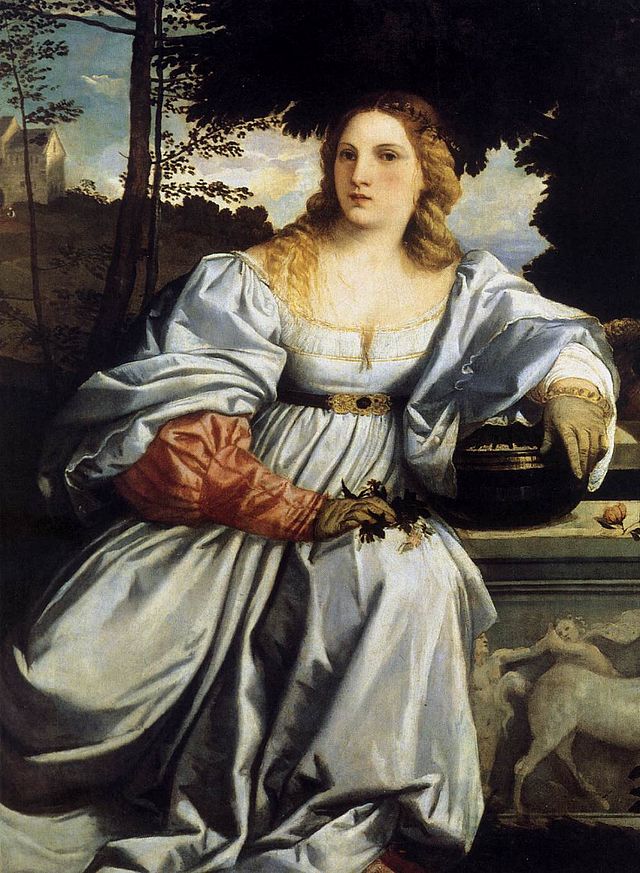
Victorian Era Ruby Necklaces
Here is the article with important phrases and sentences bolded to capture readers' attention, focusing on the history of ruby necklaces:
During the Victorian era, named after Queen Victoria of England who reigned from 1837 to 1901, we see a significant shift in the style and design of ruby made neck jewels.
This period is marked by a fascination with sentimentality, romanticism, and a renewed appreciation for the natural world, all of which had a profound impact on the jewellery of the time.
The popularity of ruby stone necklaces in Victorian England
Queen Victoria herself was a great admirer of ruby gemstones, and her personal collection included several magnificent examples.
One of the most famous was the "Timur Ruby Necklace" which featured a large, uncut ruby that had once belonged to the Mughal emperor Timur.
The queen's love for necklaces helped to popularize the ruby gemstone among the British aristocracy, who eagerly sought to emulate her style and taste.
As a result, they became a staple of Victorian jewellery, adorning the necks of ladies at court and at fashionable social events.
The Victorian era also saw the expansion of the British Empire, which had a significant impact on the ruby trade.
As the empire grew to include territories in India, Burma (modern-day Myanmar), and other parts of Asia, British jewellers gained access to a wider variety of rubies, including the highly prized "Burmese rubies" known for their deep, rich color.
This influx of rubies from across the empire fueled the demand for vintage necklaces in Victorian England, as well as in other parts of Europe and America.
The increased supply also led to a greater range of necklace designs, from simple, elegant pieces to more elaborate, ornate creations.
Necklace Fashion Through the Ages
Victorian ruby necklaces were characterized by a wide range of styles and designs, reflecting the diverse tastes and influences of the period.
Early Victorian necklaces often featured simple, delicate designs, with small rubies set in gold or silver.
As the era progressed, they became more elaborate and ornate, with larger gemstones, more intricate settings, and a greater use of other precious stones such as diamonds and pearls.
The late Victorian period saw the emergence of the "garland style" which featured clusters of rubies and other gemstones arranged in floral or foliate patterns.
Throughout the Victorian era, ruby necklaces served as important status symbols, indicating the wealth, social standing, and taste of the wearer.
The rarity and beauty of rubies, combined with their historical and cultural significance, made them highly prized and sought-after.
Owning a necklace with ruby gemstone was a mark of distinction, and many wealthy families commissioned bespoke pieces to showcase their prosperity and refinement.
These necklaces were often passed down through generations, becoming cherished family heirlooms and enduring symbols of status and prestige.
Checkout Juvetti's Latest Necklace Collection Here
Art Deco Ruby Necklaces
As we enter the 20th century, we encounter the bold and striking designs of the Art Deco period, which had a profound impact on the world of jewellery, including necklaces.
The Art Deco era, spanning roughly from the 1920s to the 1930s, is characterised by a sense of modernity, elegance, and a celebration of geometric forms and patterns.
The rise of Art Deco necklaces in the 1920s and 1930s
The Art Deco movement emerged in the aftermath of World War I, as people sought to embrace a new, modern aesthetic that reflected the changing times.
In jewellery design, this meant a shift away from the delicate, intricate styles of the Victorian and Edwardian eras, towards a bolder, more streamlined look.
Art Deco jewellery was characterised by strong, geometric shapes, clean lines, and a focus on symmetry and repetition.
Rubies, with their vibrant color and durability, were perfectly suited to this new style, and quickly became a popular choice for Art Deco necklaces.
Art Deco ruby necklaces often featured geometric and abstract designs, with rubies arranged in patterns of circles, squares, and triangles.
These designs were influenced by a range of sources, from the avant-garde art movements of the time, such as Cubism and Futurism, to the exotic and oriental motifs that were in vogue.
One popular style of Art Deco ruby gemstone necklace was the "sautoir" a long, slender necklace that often featured a tassel or pendant at the end. These necklaces were designed to be worn loose and flowing, in keeping with the relaxed, liberated spirit of the era.
Famous Historical Ruby Necklaces
One of the most famous Art Deco ruby necklaces is the "Tutti Frutti" necklace by Cartier.
Created in the 1920s, this magnificent piece features a vibrant mix of carved rubies, sapphires, and emeralds, set in a geometric pattern of diamond and platinum leaves and vines.
The "Tutti Frutti" style, which combines multiple colorful gemstones in a single piece, became a hallmark of Cartier's Art Deco jewellery, and continues to be highly sought-after by collectors today.
Another iconic Art Deco necklace is the "Coeur de Rubis" (Heart of Ruby) necklace by Van Cleef & Arpels.
Created in 1936, this stunning piece features a large, heart-shaped ruby pendant, surrounded by a border of diamonds and smaller rubies.
The "Coeur de Rubis" necklace is a testament to the skill and artistry of Van Cleef & Arpels, one of the most renowned jewellery houses of the Art Deco period.
Its bold, romantic design captures the essence of the era, and continues to inspire and captivate jewellery lovers today.
Modern History of Ruby Necklaces
As we move into the modern era, ruby jewel necklaces continue to captivate and enchant, with designs that range from classic and traditional to bold and innovative.
The 20th and 21st centuries have seen a continued appreciation for the beauty and symbolism of rubies, as well as a willingness to experiment with new styles and techniques.
The continued popularity in modern times
Contemporary jewellery designers have embraced the timeless beauty of rubies, creating necklaces that are both modern and classic.
From minimalist solitaire pendants to elaborate, statement-making pieces, they continue to be a staple of high-end jewellery collections.
One notable trend in contemporary ruby jewellery piece design is the use of mixed materials and unconventional settings.
Designers are experimenting with pairing rubies with materials such as leather, wood, and ceramic, creating pieces that are both unexpected and visually striking.
In the modern era, celebrities and royalty continue to play a significant role in shaping necklace trends.
From the elegant simplicity of Audrey Hepburn's ruby pendant in "Breakfast at Tiffany's" to the lavish ruby and diamond necklaces worn by modern-day royals such as Kate Middleton and Meghan Markle, ruby remain a symbol of sophistication and status.
Celebrity engagements and red-carpet events have also helped to popularize ruby gemstone necklaces, with many stars choosing to wear stunning ruby pieces for these high-profile occasions.
The media attention surrounding these events has helped to keep ruby in the public eye and has inspired many people to seek out their own ruby pieces.
Royal Ruby Necklaces
Queen Elizabeth II, the longest-reigning monarch in British history, is known for her impressive collection of ruby necklaces.
One of the most famous is the "Burmese Ruby Tiara" which features 96 rubies set in gold and diamond clusters.
The tiara was commissioned by the Queen in 1973 and is often worn with a matching ruby and diamond necklace.

Another notable piece is the "Oriental Circlet Tiara" which features a central ruby surrounded by diamonds and smaller rubies.
This tiara was originally created for Queen Victoria in 1853 and has been passed down through generations of royal women.
Princess Diana, known for her impeccable taste in jewellery, was often seen wearing necklaces with ruby gemstones.
One of her most famous pieces was the "Saudi Suite" a gift from the King of Saudi Arabia, which included a stunning ruby and diamond necklace, earrings, and bracelet.

In more recent years, Kate Middleton, the Duchess of Cambridge, has also been seen wearing beautiful ruby jewellery.
One notable example is the "Mouawad Ruby and Diamond Demi-Parure" which features a necklace, earrings, and bracelet set with oval-shaped rubies and diamonds.
Evolution of Ruby Necklace Design
Throughout history, the design of ruby pieces has evolved and adapted to reflect the changing tastes, styles, and technologies of each era.
From the simple beads of ancient times to the elaborate, avant-garde creations of today, they have undergone a fascinating transformation that mirrors the broader evolution of art, culture, and society.
The changing styles and techniques of vintage necklace craftsmanship
One of the most significant factors in the evolution of necklace design has been the development of new cutting and setting techniques.
In ancient times, rubies were often left in their natural, uncut state, or were polished into simple, rounded beads.
As cutting techniques advanced, however, jewellers began to experiment with new ways of shaping and faceting rubies to enhance their beauty and brilliance.
The invention of the "brilliant cut" in the 17th century, for example, allowed jewellers to create rubies with a much greater degree of sparkle and fire.
This technique, which involves carefully arranging the facets of the stone to maximize its reflective properties, has remained a staple of gemstone design to this day.
Another key factor in the evolution of ruby necklace design has been the influence of cultural and artistic movements.
Throughout history, ruby necklaces have been shaped by the prevailing styles and sensibilities of each era, from the opulence of the Baroque period to the naturalism of the Art Nouveau movement.
In the 20th century, for example, the bold, geometric styles of the Art Deco period had a profound impact on necklace design, with jewellers creating pieces that featured strong, angular lines and abstract patterns.
Similarly, the "hippie chic" aesthetic of the 1960s and 70s inspired a new generation of ruby jewellery necklaces that were more organic and free-flowing in their design.
Ruby Necklace Craftsmanship Through the Ages
In the earliest days of ruby gem necklace making, the primary technique was bead drilling and stringing.
This involved carefully drilling holes through the center of each ruby bead and then stringing them together on a length of cord or wire.
This technique was used by ancient cultures around the world, from the Indus Valley to the Mediterranean, and remained the primary method of necklace making for thousands of years.
The simplicity and elegance of these early ruby bead necklaces continue to inspire jewellery designers to this day.
In the 18th and 19th centuries, as diamond cutting and setting techniques became more advanced, ruby and diamond necklaces began to emerge as a popular style.
These necklaces often featured a central ruby surrounded by a halo of diamonds, or a series of alternating ruby and diamond clusters.
The combination of rubies and diamonds was seen as the ultimate expression of luxury and refinement, and these necklaces became a staple of high society fashion.
The Victorian era, in particular, saw a surge in the popularity of ruby and diamond necklaces, with the British royal family commissioning several notable examples.
Cultural Significance of Ruby Necklaces
Beyond their beauty and value as precious gemstones, ruby necklaces have held deep cultural and symbolic significance throughout history.
From ancient times to the present day, rubies have been associated with a wide range of meanings and beliefs, making them much more than mere adornments.
The symbolism and meaning of ruby necklaces in different cultures
One of the most enduring symbolic associations of rubies is with love, passion, and power.
In many cultures, the vibrant red color of rubies is seen as a representation of the intense emotions of the heart, as well as the strength and vitality of the human spirit.
In ancient India, for example, rubies were believed to bring peace and contentment to relationships, and were often given as gifts between lovers.
In medieval Europe, rubies were associated with the blood of Christ, and were seen as symbols of divine love and sacrifice.
Another common symbolic association of rubies is with royalty and nobility. Throughout history, ruby necklaces have been worn by kings, queens, and other members of the aristocracy as a sign of their wealth, power, and prestige.
In ancient China, for example, rubies were reserved for the exclusive use of the emperor and his inner circle, and were believed to confer wisdom and good fortune on those who wore them.
In the Western world, rubies have long been associated with the royal families of Europe, with many famous ruby gemstone necklaces passing from generation to generation as treasured heirlooms.
Ruby Necklace in Literature
Ruby made necklaces have been mentioned in literature since ancient times, often as symbols of beauty, love, and enchantment.
In the ancient Indian epic, the Mahabharata, for example, the god Krishna is described as wearing a necklace of rubies that glowed like the sun.
In classical Greek and Roman literature, rubies were often associated with the gods and goddesses of love and beauty, such as Aphrodite and Venus.
The Roman poet Ovid, in his "Metamorphoses" describes a necklace of rubies and emeralds worn by the nymph Daphne as she flees from the advances of the god Apollo.
In more recent times, ruby jewel necklaces have continued to appear in literature as powerful symbols of emotion, desire, and mystery.
In Nathaniel Hawthorne's novel "The Scarlet Letter" for example, the character Hester Prynne is forced to wear a scarlet "A" as a sign of her adultery, which is often described as a "ruby" or a "red hot iron".
In the poetry of the Romantic era, rubies were often used to symbolize the intensity and passion of the human heart.
The English poet William Blake, in his poem "The Sick Rose" describes a rose infected by an "invisible worm" whose "dark secret love / Does thy life destroy" like a "ruby-red" flame.
Archaeological Findings of Ruby Necklaces
The study of ancient ruby necklaces through archaeological findings has provided us with invaluable insights into the history, craftsmanship, and cultural significance of these precious artifacts.
From the tombs of ancient kings to the ruins of long-lost civilizations, necklaces with ruby stones have been discovered in a wide range of contexts, offering a tantalizing glimpse into the past.
The discovery of ancient ruby necklaces in archaeological sites
One of the most stunning archaeological finds of ruby necklaces came from the Ural Mountains in Russia, where a Sarmatian Queen was buried with an exquisite collection of jewellery, including a breathtaking vintage necklace.
The necklace, which dates back to the 4th century BCE, features a series of intricately carved gold beads, each inlaid with a polished ruby cabochon.
The craftsmanship and design of the necklace are a testament to the skill and artistry of ancient goldsmiths, and provide a rare glimpse into the opulent world of Sarmatian royalty.
In China, ruby antique necklaces have been found in the tombs of several ancient emperors, often alongside other precious artifacts such as jade carvings and silk robes.
These necklaces, which typically feature large, uncut rubies set in gold or bronze, were believed to confer power, wisdom, and immortality on the wearer.
One of the most famous examples is the neckpiece found in the tomb of the Wanli Emperor, who ruled during the Ming Dynasty in the 16th century.
The necklace, which features 23 large rubies set in gold filigree, is a stunning example of the opulence and artistry of Chinese imperial jewellery.
Historical Trade Routes of Rubies
The discovery of ancient ruby necklaces in far-flung corners of the world has also shed light on the complex trade networks that connected different civilizations throughout history.
One of the most significant of these was the ancient trade route that connected the ruby mines of Burma (modern-day Myanmar) with the Roman Empire.
Rubies from Burma were prized for their exceptional color and clarity, and were transported overland through India and Persia, before being shipped across the Mediterranean to Rome.
The Roman historian Pliny the Elder wrote of the incredible value placed on these "carbuncles" (the Roman term for rubies), which were worn by emperors and aristocrats as a symbol of their wealth and power.
As already mentioned - another significant trade route that played a role in the spread of ruby stone necklaces was the Silk Road, the vast network of overland and maritime routes that connected China with the West.
Rubies from Burma and other parts of Asia were traded along the Silk Road, often in exchange for other precious goods such as silk, spices, and gold.
The Silk Road also facilitated the exchange of ideas and techniques related to jewellery making, with artisans from different cultures learning from and influencing one another.
The result was a rich cross-pollination of styles and designs, with necklaces incorporating elements from Chinese, Indian, Persian, and Greco-Roman traditions.
Historical Ruby Mines
The story of ruby jewellery is inextricably linked to the history of the mines and regions that have produced these precious gemstones throughout the centuries.
From the legendary mines of Burma to the remote regions of Afghanistan and Tajikistan, the sources of the world's finest rubies have played a crucial role in shaping the cultural, economic, and political landscape of their times.
The famous ruby mines throughout history
Perhaps the most famous and storied of all ruby sources are the mines of Mogok in Burma (present-day Myanmar).
Located in a remote valley in the Pyin Oo Lwin region, the Mogok mines have been producing exceptional rubies for over 800 years, and have been the source of some of the world's most famous and valuable stones.
The rubies from Mogok are prized for their intense "pigeon's blood" color, a deep, vivid red with a slight purple hue.
This distinctive color is attributed to the unique geological conditions of the area, which produce rubies with a high chromium content and a low iron content.
The Mogok mines have a long and complex history, with control over the region passing through the hands of various empires, kingdoms, and colonial powers over the centuries.
Today, the mines are operated by the Burmese government, and the rubies produced there continue to be highly sought-after by collectors and connoisseurs around the world.
While Burma is the most famous source of rubies, other regions have also produced exceptional stones throughout history.
In particular, the mines of Afghanistan and Tajikistan have been important sources of rubies for centuries, with the stones from these regions prized for their unique colors and qualities.
The ruby mines of Afghanistan are located in the remote Badakhshan province, a rugged, mountainous region in the northeastern part of the country.
The rubies from this area are known for their deep, purplish-red color, which is attributed to the high altitude and extreme geological conditions of the region.
In Tajikistan, the most famous ruby mines are located in the Pamir Mountains, a remote and inaccessible region that has been producing rubies for over 2,000 years.
The rubies from this area are known for their bright, vibrant red color, and have been highly prized by traders and collectors throughout history.
The impact of ruby mining on local communities and economies
The history of ruby mining is not just a story of beautiful gemstones and famous necklaces, but also a complex and often troubling tale of the impact of these mines on the communities and economies that have grown up around them.
In many cases, ruby mining has been a source of great wealth and prosperity for local communities, providing employment, income, and economic opportunities in remote and underdeveloped regions.
However, the mining industry has also been associated with a range of social and environmental problems, from the exploitation of workers to the destruction of natural habitats.
In recent years, there has been a growing movement towards more ethical and sustainable mining practices, with initiatives like the Responsible Jewellery Council and the Kimberley Process working to promote transparency, accountability, and social responsibility in the global gemstone trade.
Influence of Ruby Jewel Necklaces on Modern Jewellery
The rich history and enduring beauty of ruby necklaces have had a profound influence on modern jewellery design, inspiring a new generation of artisans and connoisseurs to create and appreciate these timeless pieces.
From classic, traditional styles to bold, innovative designs, the legacy of ruby necklaces can be seen in the diverse and dynamic world of contemporary jewellery.
The enduring appeal of ruby luxury necklaces in contemporary jewellery
Despite the many changes and innovations in modern jewellery design, rubies remain a perennial favorite among designers and consumers alike.
The rich, vibrant color and exceptional durability of rubies make them a versatile and valuable gemstone, suitable for a wide range of styles and occasions.
In contemporary necklace designs, rubies are often used as a centerpiece or focal point, surrounded by diamonds, gold, or other precious materials.
Designers may also incorporate rubies into more abstract or avant-garde designs, using the gemstones to create bold, geometric shapes or asymmetrical patterns.
One notable trend in modern rubies necklace design is the use of "ruby slices" - thin, flat pieces of ruby that are cut and polished to create a unique, layered effect.
These slices are often set in minimalist, contemporary designs, creating a striking contrast between the organic beauty of the gemstone and the clean, modern lines of the setting.
In addition to modern designs, there is also a growing appreciation for vintage and antique ruby necklaces among contemporary jewellery lovers.
These pieces, which may date back decades or even centuries, are prized for their unique character, craftsmanship, and historical significance.
Vintage and antique ruby necklaces may feature a wide range of styles and designs, from the intricate, ornate pieces of the Victorian era to the bold, geometric shapes of the Art Deco period.
These necklaces are often seen as a way to connect with the rich history and cultural heritage of ruby jewellery, and to own a piece that is truly one-of-a-kind.
Many contemporary jewellery designers also draw inspiration from vintage and antique styles, creating modern pieces that pay homage to the classic designs of the past.
These "neo-vintage" or "antique-inspired" necklaces offer a unique blend of old-world charm and modern sensibility, appealing to a wide range of tastes and preferences.
The future of ruby necklaces in the jewellery industry
As we look to the future of ruby gemstones in the jewellery industry, there are many exciting developments and trends to watch.
From advances in gemstone cutting and setting techniques to new sources of ethical and sustainable rubies, the world of ruby jewellery is constantly evolving and innovating.
One area of particular interest is the use of technology in ruby jewels necklace design and production. From 3D printing and computer-aided design to laser cutting and robotic assembly, modern technology is revolutionizing the way that necklaces are created and manufactured.
At the same time, there is also a growing emphasis on sustainability, responsibility, and transparency in the ruby jewellery industry.
Consumers are increasingly concerned about the social and environmental impact of their purchases, and are seeking out brands and designers that prioritize ethical sourcing, fair labor practices, and eco-friendly production methods.
As a leader in the world of bespoke ruby jewellery, Juvetti is committed to staying at the forefront of these trends and innovations.
Our skilled artisans and designers are constantly exploring new ways to create beautiful, meaningful, and sustainable ruby necklaces that showcase the very best of contemporary design and craftsmanship.
Whether you are drawn to the timeless elegance of a classic ruby pendant, the bold, avant-garde style of a modern design, or the unique character of a vintage or antique piece, we can help you find or create the perfect vintage necklace to suit your style and sensibility.
Let us guide you on a journey through the exciting and dynamic world of contemporary ruby jewellery, and discover the endless possibilities of this timeless and enchanting gemstone.
Frequently Asked Questions (FAQ):
What does the ruby symbolize in history?
-
Throughout history, rubies have been associated with a wide range of symbolic meanings, including love, passion, power, courage, and protection. In ancient cultures, rubies were often seen as a symbol of the life force, and were believed to bring good fortune, health, and prosperity to those who wore them. In medieval Europe, rubies were associated with the blood of Christ, and were seen as a symbol of divine love and sacrifice. Today, rubies continue to be prized for their beauty and their symbolic associations with love, passion, and vitality.
What is the spiritual meaning of an antique ruby necklace?
-
In many spiritual and religious traditions, antique ruby necklaces are seen as powerful talismans and amulets, believed to confer a range of spiritual benefits on the wearer. In Hinduism, for example, rubies are associated with the root chakra, the energy center at the base of the spine that governs vitality, passion, and grounding. Wearing an antique ruby necklace is believed to stimulate this chakra, promoting feelings of strength, courage, and connection to the earth. In other traditions, rubies are seen as a symbol of divine love, and are believed to open the heart chakra and promote feelings of compassion, empathy, and unconditional love.
What is the myth of ruby?
-
There are many myths and legends associated with rubies throughout history, each reflecting the cultural and spiritual significance of this precious gemstone. One of the most famous myths comes from ancient Burma, where rubies were believed to be the tears of the gods, shed onto the earth as a gift to humanity. Another myth from ancient India tells the story of the "Ratnaraj" or "King of Rubies" a massive, flawless ruby that was said to possess the power to grant any wish or desire. In Greek mythology, rubies were associated with the blood of Adonis, the mortal lover of Aphrodite, and were believed to confer passion and desire on those who wore them.
What does wearing a ruby mean?
-
Wearing a ruby, whether in a necklace or another piece of jewellery, is often seen as a symbol of love, passion, and vitality. In many cultures, rubies are believed to promote feelings of strength, courage, and confidence, and are often worn as a talisman or amulet to ward off negative energy and attract good fortune. Wearing a ruby can also be a way to express one's personal style and taste, as these gemstones are prized for their rich, vibrant color and exceptional beauty. Ultimately, the meaning of wearing a ruby is deeply personal, and may reflect the individual's own beliefs, values, and aspirations.
What are some historical facts about rubies?
-
Rubies have been prized for their beauty and value for over 2,500 years, with the earliest known ruby artifacts dating back to ancient Burma and India.
-
In ancient China, rubies were reserved for the exclusive use of the emperor and his inner circle, and were believed to confer wisdom, good fortune, and protection from evil.
-
The famous "Black Prince's Ruby" which is actually a large red spinel, has been part of the British Crown Jewels since the 14th century, and is one of the oldest and most valuable gems in the collection.
-
The world's most expensive ruby, the "Sunrise Ruby" sold at auction in 2015 for over $30 million, setting a new record price for a ruby gemstone.
-
The ancient Sanskrit text, the "Ratnapariksha" provides detailed descriptions of the qualities and values of rubies, reflecting the sophisticated gemological knowledge of ancient Indian culture.

